Zhenyang Li
DiffuGR: Generative Document Retrieval with Diffusion Language Models
Nov 19, 2025Abstract:Generative retrieval (GR) re-frames document retrieval as a sequence-based document identifier (DocID) generation task, memorizing documents with model parameters and enabling end-to-end retrieval without explicit indexing. Existing GR methods are based on auto-regressive generative models, i.e., the token generation is performed from left to right. However, such auto-regressive methods suffer from: (1) mismatch between DocID generation and natural language generation, e.g., an incorrect DocID token generated in early left steps would lead to totally erroneous retrieval; and (2) failure to balance the trade-off between retrieval efficiency and accuracy dynamically, which is crucial for practical applications. To address these limitations, we propose generative document retrieval with diffusion language models, dubbed DiffuGR. It models DocID generation as a discrete diffusion process: during training, DocIDs are corrupted through a stochastic masking process, and a diffusion language model is learned to recover them under a retrieval-aware objective. For inference, DiffuGR attempts to generate DocID tokens in parallel and refines them through a controllable number of denoising steps. In contrast to conventional left-to-right auto-regressive decoding, DiffuGR provides a novel mechanism to first generate more confident DocID tokens and refine the generation through diffusion-based denoising. Moreover, DiffuGR also offers explicit runtime control over the qualitylatency tradeoff. Extensive experiments on benchmark retrieval datasets show that DiffuGR is competitive with strong auto-regressive generative retrievers, while offering flexible speed and accuracy tradeoffs through variable denoising budgets. Overall, our results indicate that non-autoregressive diffusion models are a practical and effective alternative for generative document retrieval.
EventTracer: Fast Path Tracing-based Event Stream Rendering
Aug 25, 2025

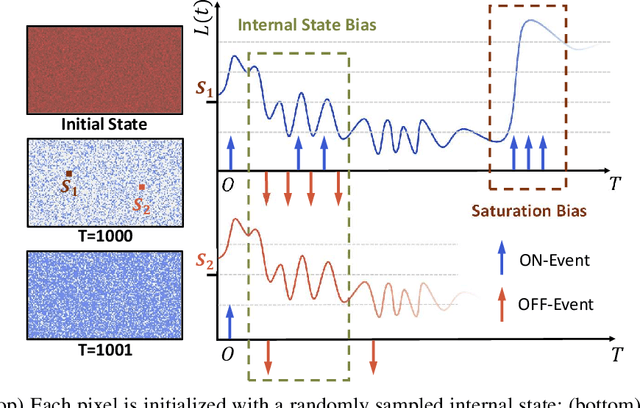

Abstract:Simulating event streams from 3D scenes has become a common practice in event-based vision research, as it meets the demand for large-scale, high temporal frequency data without setting up expensive hardware devices or undertaking extensive data collections. Yet existing methods in this direction typically work with noiseless RGB frames that are costly to render, and therefore they can only achieve a temporal resolution equivalent to 100-300 FPS, far lower than that of real-world event data. In this work, we propose EventTracer, a path tracing-based rendering pipeline that simulates high-fidelity event sequences from complex 3D scenes in an efficient and physics-aware manner. Specifically, we speed up the rendering process via low sample-per-pixel (SPP) path tracing, and train a lightweight event spiking network to denoise the resulting RGB videos into realistic event sequences. To capture the physical properties of event streams, the network is equipped with a bipolar leaky integrate-and-fired (BiLIF) spiking unit and trained with a bidirectional earth mover distance (EMD) loss. Our EventTracer pipeline runs at a speed of about 4 minutes per second of 720p video, and it inherits the merit of accurate spatiotemporal modeling from its path tracing backbone. We show in two downstream tasks that EventTracer captures better scene details and demonstrates a greater similarity to real-world event data than other event simulators, which establishes it as a promising tool for creating large-scale event-RGB datasets at a low cost, narrowing the sim-to-real gap in event-based vision, and boosting various application scenarios such as robotics, autonomous driving, and VRAR.
Enhanced Velocity Field Modeling for Gaussian Video Reconstruction
Jul 31, 2025Abstract:High-fidelity 3D video reconstruction is essential for enabling real-time rendering of dynamic scenes with realistic motion in virtual and augmented reality (VR/AR). The deformation field paradigm of 3D Gaussian splatting has achieved near-photorealistic results in video reconstruction due to the great representation capability of deep deformation networks. However, in videos with complex motion and significant scale variations, deformation networks often overfit to irregular Gaussian trajectories, leading to suboptimal visual quality. Moreover, the gradient-based densification strategy designed for static scene reconstruction proves inadequate to address the absence of dynamic content. In light of these challenges, we propose a flow-empowered velocity field modeling scheme tailored for Gaussian video reconstruction, dubbed FlowGaussian-VR. It consists of two core components: a velocity field rendering (VFR) pipeline which enables optical flow-based optimization, and a flow-assisted adaptive densification (FAD) strategy that adjusts the number and size of Gaussians in dynamic regions. We validate our model's effectiveness on multi-view dynamic reconstruction and novel view synthesis with multiple real-world datasets containing challenging motion scenarios, demonstrating not only notable visual improvements (over 2.5 dB gain in PSNR) and less blurry artifacts in dynamic textures, but also regularized and trackable per-Gaussian trajectories.
Joint Flashback Adaptation for Forgetting-Resistant Instruction Tuning
May 21, 2025Abstract:Large language models have achieved remarkable success in various tasks. However, it is challenging for them to learn new tasks incrementally due to catastrophic forgetting. Existing approaches rely on experience replay, optimization constraints, or task differentiation, which encounter strict limitations in real-world scenarios. To address these issues, we propose Joint Flashback Adaptation. We first introduce flashbacks -- a limited number of prompts from old tasks -- when adapting to new tasks and constrain the deviations of the model outputs compared to the original one. We then interpolate latent tasks between flashbacks and new tasks to enable jointly learning relevant latent tasks, new tasks, and flashbacks, alleviating data sparsity in flashbacks and facilitating knowledge sharing for smooth adaptation. Our method requires only a limited number of flashbacks without access to the replay data and is task-agnostic. We conduct extensive experiments on state-of-the-art large language models across 1000+ instruction-following tasks, arithmetic reasoning tasks, and general reasoning tasks. The results demonstrate the superior performance of our method in improving generalization on new tasks and reducing forgetting in old tasks.
Evaluating Model Robustness Using Adaptive Sparse L0 Regularization
Aug 28, 2024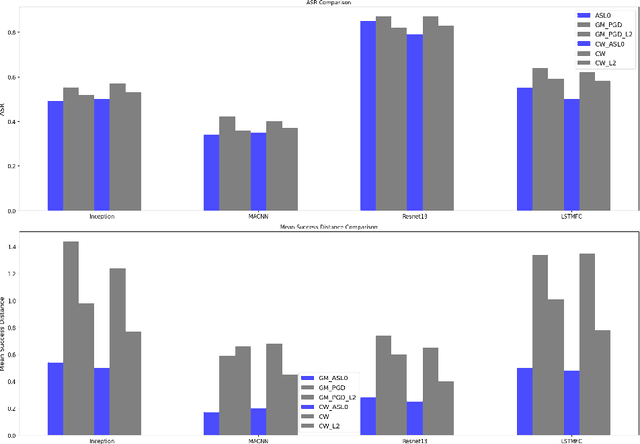
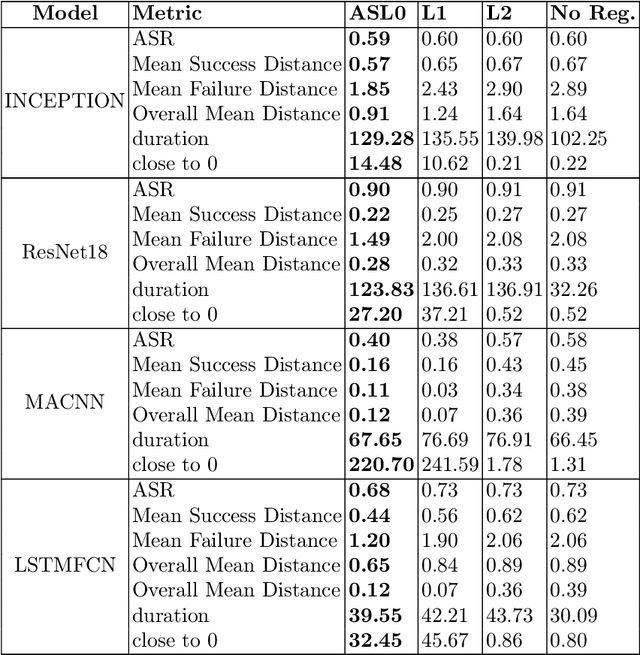
Abstract:Deep Neural Networks have demonstrated remarkable success in various domains but remain susceptible to adversarial examples, which are slightly altered inputs designed to induce misclassification. While adversarial attacks typically optimize under Lp norm constraints, attacks based on the L0 norm, prioritising input sparsity, are less studied due to their complex and non convex nature. These sparse adversarial examples challenge existing defenses by altering a minimal subset of features, potentially uncovering more subtle DNN weaknesses. However, the current L0 norm attack methodologies face a trade off between accuracy and efficiency either precise but computationally intense or expedient but imprecise. This paper proposes a novel, scalable, and effective approach to generate adversarial examples based on the L0 norm, aimed at refining the robustness evaluation of DNNs against such perturbations.
Powerful and Flexible: Personalized Text-to-Image Generation via Reinforcement Learning
Jul 09, 2024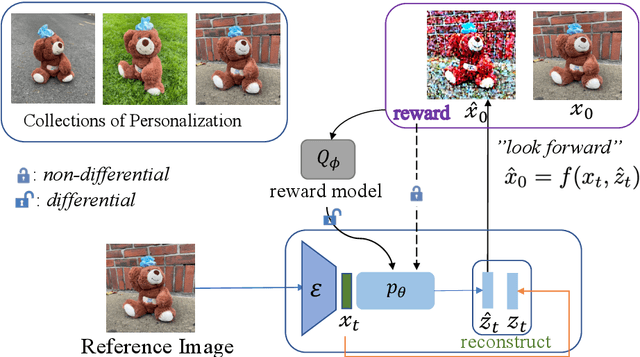
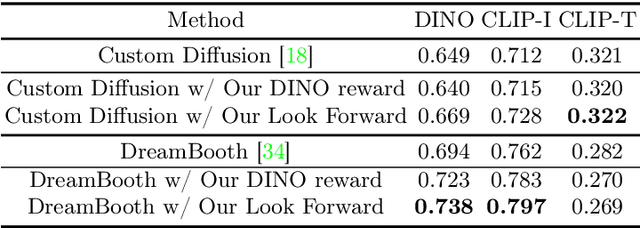

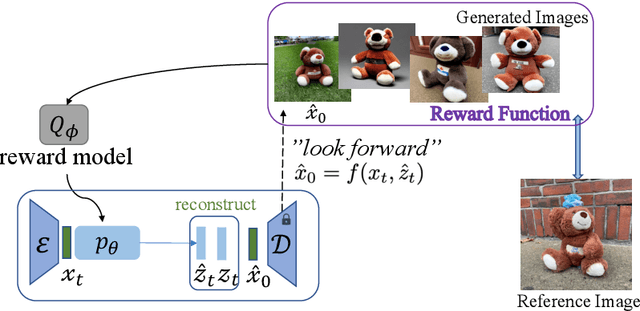
Abstract:Personalized text-to-image models allow users to generate varied styles of images (specified with a sentence) for an object (specified with a set of reference images). While remarkable results have been achieved using diffusion-based generation models, the visual structure and details of the object are often unexpectedly changed during the diffusion process. One major reason is that these diffusion-based approaches typically adopt a simple reconstruction objective during training, which can hardly enforce appropriate structural consistency between the generated and the reference images. To this end, in this paper, we design a novel reinforcement learning framework by utilizing the deterministic policy gradient method for personalized text-to-image generation, with which various objectives, differential or even non-differential, can be easily incorporated to supervise the diffusion models to improve the quality of the generated images. Experimental results on personalized text-to-image generation benchmark datasets demonstrate that our proposed approach outperforms existing state-of-the-art methods by a large margin on visual fidelity while maintaining text-alignment. Our code is available at: \url{https://github.com/wfanyue/DPG-T2I-Personalization}.
Training-free CryoET Tomogram Segmentation
Jul 08, 2024



Abstract:Cryogenic Electron Tomography (CryoET) is a useful imaging technology in structural biology that is hindered by its need for manual annotations, especially in particle picking. Recent works have endeavored to remedy this issue with few-shot learning or contrastive learning techniques. However, supervised training is still inevitable for them. We instead choose to leverage the power of existing 2D foundation models and present a novel, training-free framework, CryoSAM. In addition to prompt-based single-particle instance segmentation, our approach can automatically search for similar features, facilitating full tomogram semantic segmentation with only one prompt. CryoSAM is composed of two major parts: 1) a prompt-based 3D segmentation system that uses prompts to complete single-particle instance segmentation recursively with Cross-Plane Self-Prompting, and 2) a Hierarchical Feature Matching mechanism that efficiently matches relevant features with extracted tomogram features. They collaborate to enable the segmentation of all particles of one category with just one particle-specific prompt. Our experiments show that CryoSAM outperforms existing works by a significant margin and requires even fewer annotations in particle picking. Further visualizations demonstrate its ability when dealing with full tomogram segmentation for various subcellular structures. Our code is available at: https://github.com/xulabs/aitom
Do Vision-Language Transformers Exhibit Visual Commonsense? An Empirical Study of VCR
May 27, 2024


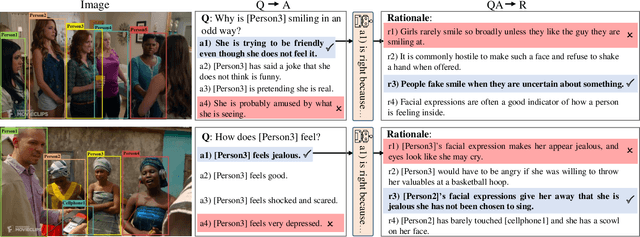
Abstract:Visual Commonsense Reasoning (VCR) calls for explanatory reasoning behind question answering over visual scenes. To achieve this goal, a model is required to provide an acceptable rationale as the reason for the predicted answers. Progress on the benchmark dataset stems largely from the recent advancement of Vision-Language Transformers (VL Transformers). These models are first pre-trained on some generic large-scale vision-text datasets, and then the learned representations are transferred to the downstream VCR task. Despite their attractive performance, this paper posits that the VL Transformers do not exhibit visual commonsense, which is the key to VCR. In particular, our empirical results pinpoint several shortcomings of existing VL Transformers: small gains from pre-training, unexpected language bias, limited model architecture for the two inseparable sub-tasks, and neglect of the important object-tag correlation. With these findings, we tentatively suggest some future directions from the aspect of dataset, evaluation metric, and training tricks. We believe this work could make researchers revisit the intuition and goals of VCR, and thus help tackle the remaining challenges in visual reasoning.
Point Resampling and Ray Transformation Aid to Editable NeRF Models
May 12, 2024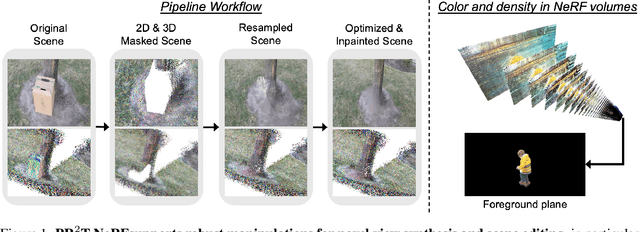

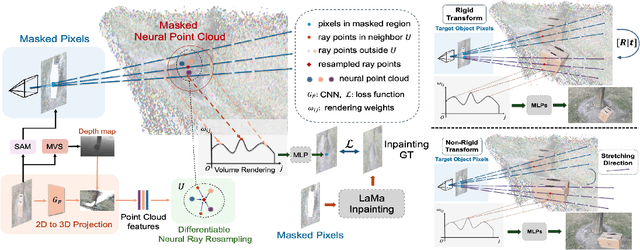

Abstract:In NeRF-aided editing tasks, object movement presents difficulties in supervision generation due to the introduction of variability in object positions. Moreover, the removal operations of certain scene objects often lead to empty regions, presenting challenges for NeRF models in inpainting them effectively. We propose an implicit ray transformation strategy, allowing for direct manipulation of the 3D object's pose by operating on the neural-point in NeRF rays. To address the challenge of inpainting potential empty regions, we present a plug-and-play inpainting module, dubbed differentiable neural-point resampling (DNR), which interpolates those regions in 3D space at the original ray locations within the implicit space, thereby facilitating object removal & scene inpainting tasks. Importantly, employing DNR effectively narrows the gap between ground truth and predicted implicit features, potentially increasing the mutual information (MI) of the features across rays. Then, we leverage DNR and ray transformation to construct a point-based editable NeRF pipeline PR^2T-NeRF. Results primarily evaluated on 3D object removal & inpainting tasks indicate that our pipeline achieves state-of-the-art performance. In addition, our pipeline supports high-quality rendering visualization for diverse editing operations without necessitating extra supervision.
Attribute-driven Disentangled Representation Learning for Multimodal Recommendation
Dec 22, 2023

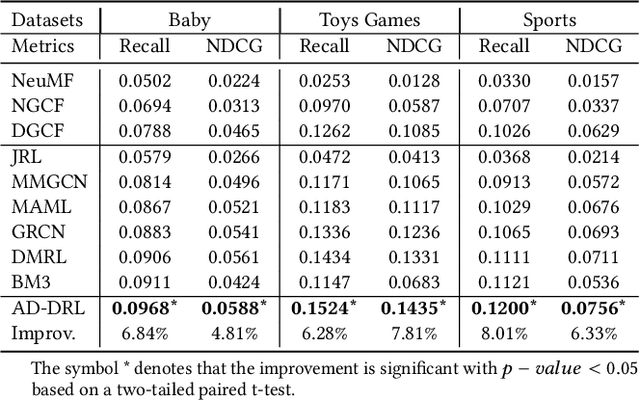
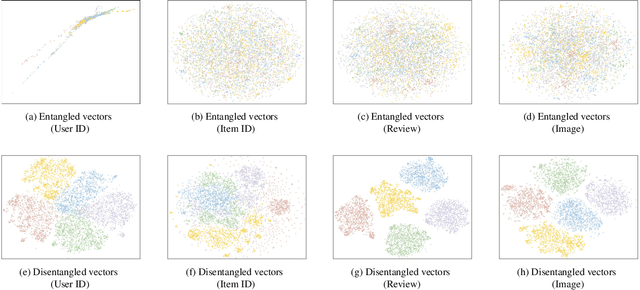
Abstract:Recommendation algorithms forecast user preferences by correlating user and item representations derived from historical interaction patterns. In pursuit of enhanced performance, many methods focus on learning robust and independent representations by disentangling the intricate factors within interaction data across various modalities in an unsupervised manner. However, such an approach obfuscates the discernment of how specific factors (e.g., category or brand) influence the outcomes, making it challenging to regulate their effects. In response to this challenge, we introduce a novel method called Attribute-Driven Disentangled Representation Learning (short for AD-DRL), which explicitly incorporates attributes from different modalities into the disentangled representation learning process. By assigning a specific attribute to each factor in multimodal features, AD-DRL can disentangle the factors at both attribute and attribute-value levels. To obtain robust and independent representations for each factor associated with a specific attribute, we first disentangle the representations of features both within and across different modalities. Moreover, we further enhance the robustness of the representations by fusing the multimodal features of the same factor. Empirical evaluations conducted on three public real-world datasets substantiate the effectiveness of AD-DRL, as well as its interpretability and controllability.
 Add to Chrome
Add to Chrome Add to Firefox
Add to Firefox Add to Edge
Add to Edge